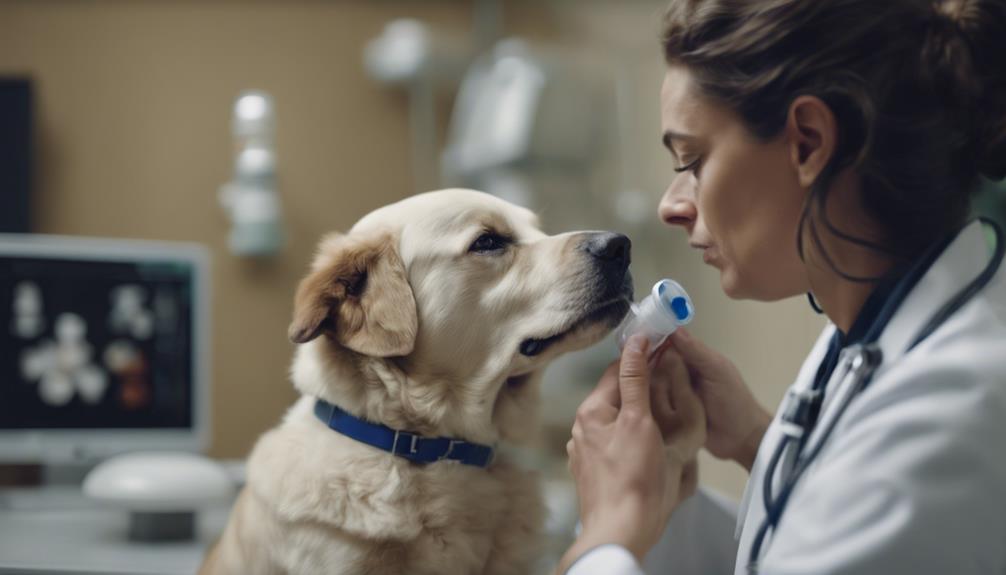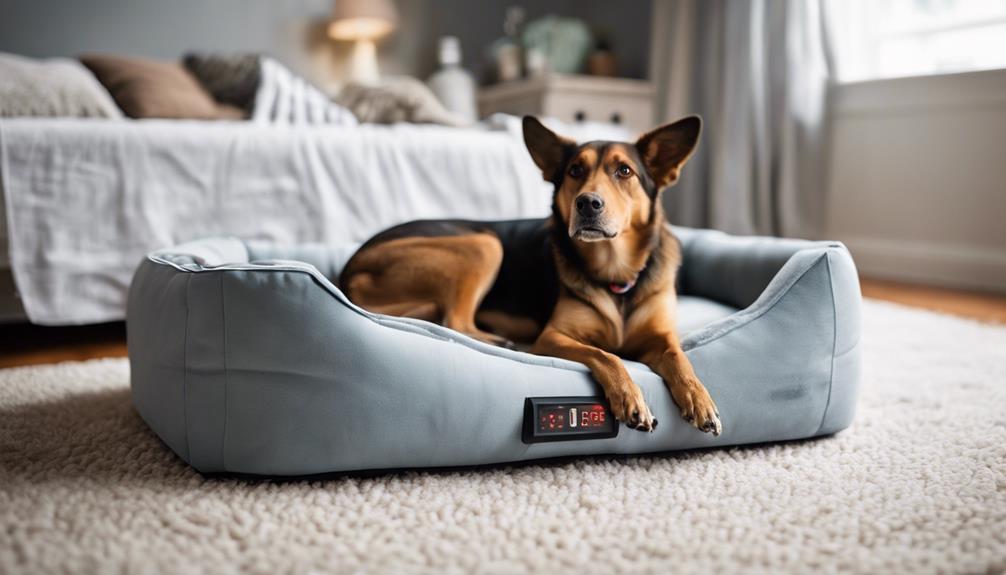In the realm of veterinary medicine, the possibility of asthma affecting dogs raises intriguing questions regarding the management of their respiratory health. While the condition is relatively rare in canines, the challenges posed by breathing difficulties in our four-legged companions demand a thorough understanding of the signs, triggers, and treatment modalities associated with asthmatic episodes.
From the identification of allergens to the implementation of tailored medication regimens, exploring the nuances of canine asthma offers crucial insights into safeguarding our pups' well-being.
Key Takeaways
- Dogs can have asthma, diagnosed through thorough veterinary examinations.
- Management tailored to specific triggers helps alleviate asthma symptoms.
- Regular veterinary check-ups crucial for brachycephalic breeds prone to respiratory issues.
- Environmental management, including allergen control, is vital for asthmatic dogs' well-being.
Asthma in Dogs: Veterinary Diagnoses
When diagnosing asthma in dogs, veterinarians conduct thorough examinations to pinpoint the underlying cause of the breathing difficulties. This process often involves evaluating the dog's medical history, conducting physical examinations, and may include diagnostic tests such as X-rays, blood tests, and bronchoscopy.
Veterinarians pay close attention to symptoms like coughing, wheezing, rapid breathing, and any triggers that may worsen the condition. By ruling out other potential causes of respiratory distress, such as infections or heart conditions, veterinarians can provide an accurate asthma diagnosis.
This precise approach ensures that the treatment plan tailored for the dog addresses the specific asthma triggers, leading to effective management of the condition and improved quality of life for the pet.
Breathing Problems in Brachycephalic Breeds
Brachycephalic breeds of dogs are prone to breathing problems due to their unique anatomical features. These breeds, such as Bulldogs, Pugs, and Boston Terriers, have shortened skulls and compressed airways, leading to respiratory issues.
The conformation of their skull and soft tissue in their upper airway can cause breathing difficulties, especially when they are stressed, overheated, or exercising. Brachycephalic obstructive airway syndrome (BOAS) is a common condition in these breeds, characterized by noisy breathing, snoring, and intolerance to exercise.
Owners of brachycephalic dogs should be vigilant for signs of respiratory distress and consult with a veterinarian if any breathing abnormalities are observed. Regular veterinary check-ups are crucial for managing and addressing potential breathing problems in these breeds.
Signs of Asthma Attacks in Dogs

Asthma attacks in dogs can manifest through various signs and symptoms that may indicate a respiratory distress episode requiring immediate attention from a veterinarian.
- Wheezing
- Labored breathing
- Persistent coughing
Common Symptoms of Asthma in Dogs
Common signs that may indicate asthma in dogs include wheezing, labored breathing, and persistent coughing, which necessitate prompt veterinary evaluation for proper diagnosis and treatment. Dogs with asthma may exhibit symptoms such as difficulty breathing, rapid breathing, a bluish tongue, and lethargy. Wheezing is another common symptom that owners should watch out for.
These signs can vary in intensity, with some dogs experiencing mild symptoms while others may have severe breathing difficulties. If you notice any of these symptoms in your dog, it is essential to consult a veterinarian for a thorough evaluation. Early detection and management of asthma in dogs are crucial for ensuring their well-being and quality of life.
Allergies as Triggers for Dog Asthma

Allergies play a significant role as triggers for asthma in dogs, necessitating careful identification and management to alleviate respiratory distress. Allergic reactions can exacerbate asthma symptoms in dogs, leading to potentially life-threatening situations.
To effectively address allergies as triggers for dog asthma, consider the following:
- Identifying Allergens: Pinpointing specific allergens through veterinary consultation and testing is crucial for developing a targeted management plan.
- Controlling Exposure: Implement strategies to minimize your dog's exposure to common allergens like pollen, dust mites, and cigarette smoke.
- Medication Management: Working closely with a veterinarian to prescribe appropriate medications to alleviate allergic reactions and manage asthma symptoms effectively.
Identifying Allergies in Dogs
To effectively manage respiratory issues in dogs, identifying specific allergens through veterinary consultation and testing is essential. Allergies, especially to common airborne triggers like pollen, dust mites, cigarette smoke, and perfumes, can exacerbate asthma symptoms in dogs. Veterinary professionals can conduct tests to pinpoint the exact allergens affecting your dog, enabling targeted treatment and allergen avoidance strategies.
| Allergen | Testing Methods | Treatment Options |
|---|---|---|
| Pollen | Skin Prick Test | Allergy Shots, Antihistamines |
| Dust Mites | Blood Test | Air Purifiers, Wash Bedding Often |
| Cigarette Smoke | Intradermal Test | Limit Exposure, Keep Home Smoke-Free |
| Perfumes | Elimination Diet | Avoidance, Use Fragrance-Free Products |
Prescription Inhalers for Asthma Treatment

In the management of asthma in dogs, prescription inhalers play a crucial role in alleviating respiratory symptoms and improving breathing function. These inhalers deliver medication directly to the lungs, targeting inflammation and constriction of the airways. They are commonly prescribed by veterinarians to help dogs with asthma breathe more comfortably and lead a better quality of life.
Inhalers are designed to deliver precise doses of medication, ensuring effectiveness.
Different types of inhalers are available, including metered-dose inhalers and dry powder inhalers, providing options tailored to individual dogs' needs.
Using a spacer device with the inhaler can enhance drug delivery and improve the effectiveness of the treatment regimen.
Guidance on Using Inhalers for Dogs
When administering inhalers to dogs for asthma treatment, proper technique and consistent dosing are essential for optimal effectiveness and management of respiratory symptoms. Veterinarians provide guidance on using inhalers correctly to ensure the medication reaches the lungs efficiently. Here is a table highlighting key points to remember when using inhalers for dogs:
| Guidance on Using Inhalers for Dogs | Important Points |
|---|---|
| Shake the inhaler before each use | Ensures proper dispersion of medication |
| Use a spacer device if available | Helps deliver medication directly to the lungs |
| Administer medication during calm moments | Allows for better inhalation and absorption |
| Watch for signs of improvement or worsening | Adjust treatment as needed based on response |
| Keep inhalers stored properly | Ensure medication remains effective for treatment |
Preventative Measures for Asthma in Dogs

Implementing proactive strategies to reduce the risk of asthma exacerbations in dogs involves meticulous attention to environmental factors and allergen control.
Here are three key preventative measures for managing asthma in dogs:
- Regular Cleaning: Keeping your dog's living environment clean, including vacuuming carpets, washing bedding frequently, and dusting surfaces, can help reduce exposure to allergens.
- Air Purifiers: Investing in a high-quality air purifier can help remove airborne irritants like dust, pollen, and mold spores, promoting better air quality for your dog.
- Limiting Fragrances: Avoid using strong perfumes, air fresheners, or scented products around your dog, as these can trigger asthma symptoms and exacerbate breathing difficulties.
Managing Asthma Symptoms in Dogs
To effectively manage asthma symptoms in dogs, maintaining a clean living environment and minimizing exposure to potential triggers are essential practices. Regular cleaning of the dog's living space, including frequent vacuuming, washing bedding in hot water, and using air purifiers, can help reduce allergens that may exacerbate asthma symptoms.
Additionally, limiting the use of fragrances, such as scented candles or air fresheners, can prevent respiratory irritation in asthmatic dogs. Ensuring good ventilation in the home and avoiding exposure to smoke, dust, and pollen are also crucial steps in managing asthma symptoms.
Regular Cleaning for Asthmatic Dogs

Maintaining a consistent cleaning regimen is crucial for managing asthma symptoms in dogs effectively. Regular cleaning helps reduce allergens and irritants that can trigger asthma attacks in your furry companion. Here are three essential cleaning practices to consider:
- Vacuum your home frequently to remove dust, dander, and other allergens from carpets, rugs, and furniture.
- Wash your dog's bedding, toys, and blankets regularly in hot water to eliminate allergens and keep their living environment clean.
- Use pet-safe cleaning products to clean floors, walls, and other surfaces to prevent the buildup of dust and mold, which can exacerbate asthma symptoms in dogs.
Air Purifiers for Asthmatic Dogs
Have you considered the effectiveness of air purifiers in alleviating asthma symptoms in dogs?
Air purifiers can play a crucial role in managing asthma in dogs by removing airborne allergens that may trigger respiratory issues. These devices work by filtering out particles like dust mites, pollen, and pet dander, which are common asthma triggers for dogs. By improving the air quality in your home, air purifiers can help reduce the likelihood of asthma attacks and alleviate breathing difficulties in asthmatic dogs.
When choosing an air purifier for your dog, opt for one with a HEPA filter to ensure efficient removal of allergens from the air. Introducing an air purifier into your dog's living space can significantly contribute to their respiratory health and overall well-being.
Limiting Fragrances for Asthmatic Dogs

In managing asthma in dogs, it is essential to minimize exposure to fragrances as they can act as triggers for respiratory distress in asthmatic dogs. Fragrances, whether from perfumes, scented candles, or air fresheners, can irritate the sensitive respiratory systems of dogs with asthma, leading to exacerbation of symptoms and potentially triggering an asthma attack.
To limit fragrances for asthmatic dogs:
- Choose unscented or fragrance-free grooming products for your dog.
- Avoid using scented cleaning products or detergents on your dog's bedding or in areas where they spend time.
- Opt for natural alternatives like baking soda or vinegar for cleaning to reduce the presence of artificial fragrances in your dog's environment.
Conclusion
In conclusion, the presence of asthma in dogs, though uncommon, requires vigilant monitoring and prompt intervention by veterinary professionals. Recognizing the signs and symptoms, such as labored breathing and coughing, is crucial for timely diagnosis and treatment.
Allergies, particularly to airborne irritants, play a significant role in triggering asthmatic episodes in canines. By implementing prescribed medications, environmental modifications, and regular cleaning practices, the management of asthma symptoms in dogs can be effectively achieved.




